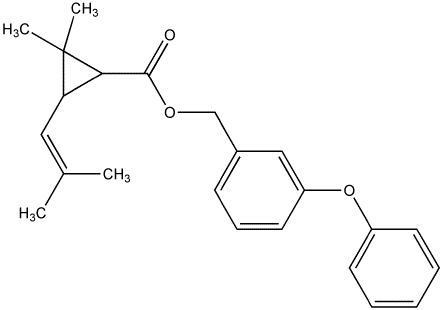Formula C23H26O3 Pubchem 4767 | Molar mass 350.451 g/mol | |
 | ||
Phenothrin, also called sumithrin and d-phenothrin, is a synthetic pyrethroid that kills adult fleas and ticks. It has also been used to kill head lice in humans. d-Phenothrin is used as a component of aerosol insecticides for domestic use. Phenothrin is often used with methoprene, an insect growth regulator that interrupts the insect's biological life cycle by killing the eggs. Phenothrin is the active agent in the branded product Raid Fly & Wasp Killer.
Contents
How to pronounce phenothrin
Effects
Phenothrin is primarily used to kill fleas and ticks. It is also used to kill head lice in humans, but studies conducted in Paris, France and the United Kingdom have shown widespread resistance to phenothrin.
It is extremely toxic to bees. An U.S. Environmental Protection Agency (EPA) study found that 0.07 micrograms was enough to kill honey bees. It is also extremely toxic to aquatic life with a study showing concentrations of 0.03 ppb killing mysid shrimp. It has increased risk of liver cancer in rats and mice in long term exposure. It is capable of killing mosquitoes, although remains poisonous to cats and dogs, with seizures and deaths being reported due to poisoning. Specific data on concentrations or exposure is lacking.
Phenothrin has been found to possess antiandrogen properties, and was responsible for a small epidemic of gynecomastia via isolated environmental exposure.
The EPA has not assessed its effect on cancer in humans. However, one study performed by the Mt. Sinai School of Medicine links sumithrin with breast cancer; the link made by sumithrin's effect on increasing the expression of a gene responsible for mammary tissue proliferation.
EPA action
In 2005, the U.S. EPA canceled permission to use phenothrin in several flea and tick products, at the request of the manufacturer, Hartz Mountain Industries. The products were linked to a range of adverse reactions, including hair loss, salivation, tremors, and numerous deaths in cats and kittens. In the short term, the agreement called for new warning labels on the products.
As of March 31, 2006, the sale and distribution of Hartz's phenothrin-containing flea and tick products for cats has been terminated. However, EPA's product cancellation order did not apply to Hartz flea and tick products for dogs, and Hartz continues to produce many of its flea and tick products for dogs.
